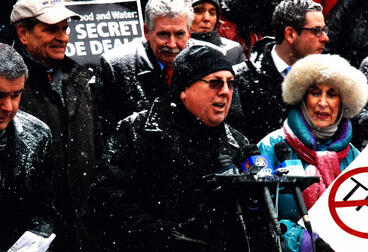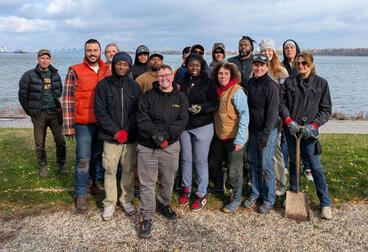Aging infrastructure has long been a contention of the IBEW throughout the United States and especially the Northeast region as many of the power transmission lines installed were part of the bold initiatives in the 1935 New Deal public policy initiative by then President Franklin Delano Roosevelt through his Works Progress Administration (WPA), the government-sponsored economic plan that would help pull America out of the Great Depression by putting Americans back to work. Part of the campaign platform of many Democrat presidential candidates over the last series of elections has been for real investment of money and personnel to repair and modernize America’s infrastructure energy grid.
As New York State Governor Andrew Cuomo pushes for electrical generation, transmission, and distribution infrastructure repair and upgrade, the debate over the positive and negative impacts of the proposed Champlain Hudson Power Express (CHPE) rises to the forefront.
The CHPE project is a proposal financed by Transmission Developers Inc. (TDI), an energy facilitator funded by the Blackstone Group. As is the object of any investment firm, Blackstone’s goal is to get the greatest return for its investors. And as is generally the case, the investment goals consider short term cost savings and income for investors in consideration of proposed projects without regard to the consistent negative impact to short term and long term job prospects of local workers and revenue to the local community.
The Champlain Hudson project proposal plan is to run transmission lines from a Canadian power supplier through Lake Champlain along railroad right of ways, then south of Albany, NY, the cables will enter the Hudson River and complete its journey to a powerhouse in Astoria Queens. The transmission will be 1,000 megawatts of High Voltage Direct Current (HVdc) that will meet at the converter station in Astoria and then distribute Alternating Current to homes and businesses in the New York Metropolitan area. TDI boasts that they are offering New York State (NYS) a clean cheap power alternative in comparison to the existing means of power generation in NYS. This is all well and good as NYS strives for energy efficiency, to reduce and eliminate its carbon footprint. TDI also claims its project will offer “thousands of new jobs, millions of dollars of new economic activity and lower energy prices for consumers.” This is very appealing for all New Yorkers on the surface.
But why would NYS want to remove its energy independence to another country? Add to this question the recurring circumstance that in providing the greatest return to wealthy investors the cost of that revenue comes at the price of underfunding and a reduced work force many times to the point of operative inadequacies where local communities are left on the hook to rescue the project after the money backers are gone. And will the jobs be good-paying jobs for all workers and communities?
After extensive research at the request of IBEW Local 97 President, Business Manager, and Financial Secretary Ted Skerpon, Business Representative Phil Wilcox prepared a brief explaining the “abundant excess capacity” of upstate generated power that also exposes the inadequate transmission lines that are vital to distributing power to the New York City metropolitan area. The report then offers an alternative proposal to upgrade the NY power grid especially the upstate to downstate transmission lines that suffer “transmission congestion” and with the desire for “NYS investor-owned” utilities transmission lines.
In the study performed by economists and energy professionals, the CHPE would cause the closing of western NY power plants eliminating the jobs of thousands of IBEW workers that would have a compounding negative effect on local communities and businesses near each plant. The existing plants can surely use modernization but to scrap and replace in one sweep with Canadian power where savings do not justify such abandonment is comparable to “dumping” by a cheaper product from one nation to another.
The transition of existing western NY plants could see a gradual conversion to renewable energy. Accompanying the Local 97 report was further analysis by State Transmission Assessment and Reliability Study (STARS). That evaluation showed that western NY has the greatest potential for expansion and upgrade to existing power plants. Also that repairing existing power lines will have less of an invasion of the environment and be less expensive while creating more jobs. It is impossible not to see or accept that renewables (wind and solar) with continual technological improvements in both is the future. The idea for communities is accomplishing this transition with as little damage to the environment while the projects are in operation without any employment disruption.
Strikingly not all elected officials who have been and are friends to organized labor are aware of this study that accepting power from Canada, the CHPE project, and not from NYS power plants is detrimental to long-term job growth for New York workers throughout upstate and downstate. Yet all agree that transmission lines demand upgrade.
It is up to the members of Local 3 and all locals of the IBEW in NYS to inform their elected officials that infrastructure of existing power plants and transmission lines together will ensure long-term prospects for job growth in NYS. Leading the charge in favor of the CHPE consist of the usual cast of anti-labor organizations; The New York League of Conservative Voters, and North Country Chamber of Commerce along with others.
Currently in New York State there are a variety of private and municipal-run utilities. Steuben Rural Electric Coop Inc. is the one member-owned electric cooperative utility. There are twelve (12) publically owned utilities, two (2) wholesale power marketers, twenty-nine (29) retail power marketers, two (2) state and 1 (one) Municipal Marketing Power Authority. The other seven (7) power distributors such as Niagara Mohawk Power Corporation (National Grid) and Con Edison Company of New York Inc. to name two are investor-owned. It is the responsibility of these companies to generate, transmit, and distribute power to customers throughout NYS. Oversight for municipal-run utilities comes from locally elected officials from the jurisdiction of that utility. Investor-owned utilities oversight come from Public Utility Commissions (PUC’s) that follow specific regulatory protocol. Some of the aforementioned utilities could be affected by CHPE.
Throughout the 20th and into the 21th century New York State and most of the United States has experienced debate towards conservation of natural resources and a turn back towards increased use of natural resources. Through innovations and advances in technology and decreased demand on individual energy consumption countered by a growing population and concerns of climate change power consumption from other than fossil fuel would drive the demand and innovation for alternative renewable energy provision. New York would experience a number of nuclear power plants in Shoreham NY on Long Island and Indian Point on the mainland of New York State. There is also the rebirth of the belief by many in academia and the science community that energy provision should not be a financial investment opportunity but should be structured as a human right the same as healthcare.
And throughout all the discussions about the direction of energy provision the officers and members of the IBEW have monitored and acted when necessary in order to preserve the ideals of the New Deal economy. And today in the gig economy, the data revolution, that virtuous economic maxim is under attack. The truth is people still have to go to work (powerhouses and transmission lines have to be built and maintained) so why would the constant pursuit by others to eliminate jobs deserve the support of workers anywhere.
This is when we return to Trade Unions for Energy Democracy (TUED). Putting the decision-making process of power generation, transmission, and distribution, communities and worker’s rights into the hands of the people. The regions of NYS providing power to NYS will benefit from proper legislation that protects consumers, workers and their communities.
Date Posted


